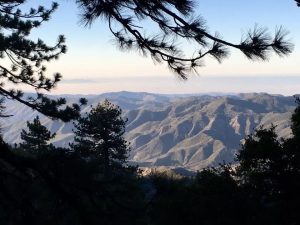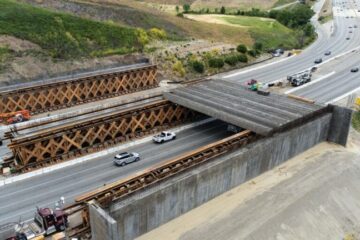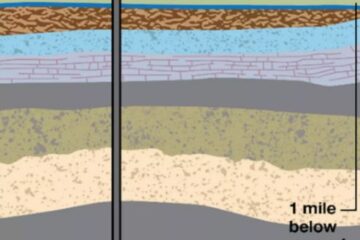Legal fight to halt forest thinning on Pine Mountain
Federal plan to thin forest draws lawsuits from Patagonia, Ojai and others
Source of this article, the Los Angeles Times, May 3, 2022

Pine Mountain, north of Ojai, provides a bird’s eye view of the sunrises and sunsets in Los Padres National Forest.
(Stuart Leavenworth / Los Angeles Times)
The popular Ventura-based clothing brand Patagonia, the city of Ojai, Ventura County and several environmental groups are suing the U.S. Forest Service in an attempt to stop a forest-thinning project on Pine Mountain in the Los Padres National Forest.
The Reyes Peak Forest Health and Fuels Reduction Project, first proposed in 2020, would thin and trim 755 acres of forestland, which the Forest Service says would alleviate firefighting risks.
But in lawsuits filed last week in federal court, plaintiffs say the project was improperly vetted, would damage the area’s flora, fauna and cultural history, and is a vestige of Trump administration logging initiatives.
“We don’t think there is much, if any, merit behind their proposal,” said Jeff Kuyper, executive director of Los Padres ForestWatch, an advocacy group that filed its suit with Patagonia, the Keep Sespe Wild Committee, the Earth Island Institute, the American Alpine Club, the Center for Biological Diversity and the California Chaparral Institute.
Ventura County and the city of Ojai filed their own suits.
The forest-thinning project was immediately controversial, with conservation groups, local government officials and the Coastal Band of the Chumash Nation opposing it.
“We’re fighting for our sacred sites in the face of what is continued colonization and imperialism,” Maura Sullivan, a representative for the Coastal Band of the Chumash Nation, told The Times in 2020.
“Pine Mountain is 90 minutes from our corporate headquarters,” said Patagonia spokesman J.J. Huggins. “It is a favorite location for our employees and our customers because of the outdoor recreation opportunities out there. … It’s magical. It is a different realm of wildlife out there.”
The Forest Service declined to comment on the litigation, but agency officials defended the plan when it was first proposed, saying it was not a logging project.
“That location was designated because of insect and disease treatment,” Forest Service project manager Katherine Worn told The Times in 2020. “And it’s on a ridge top, and that’s where you would put a fuel break.”
In a 2020 letter outlining the scope of the project, Forest Service district ranger John Smith wrote: “Within the project area, there is a need to reduce surface and ladder fuels, reduce potential fire intensities and make the area more resilient to wildfire. The most appropriate fuel treatment strategy is often thinning (removing ladder fuels and decreasing crown density) followed by prescribed fire, piling and burning piled fuels.”
But conservation officials, and recent studies of California wildfires, find that justification flawed.
“If you look at the best science out there, it consistently told us that the best way to protect communities from wildfire is not to construct fuel breaks deep in the wilderness,” Kuyper said, adding that more effective strategies included retrofitting homes and structures to be more fire-resistant and developing and maintaining defensible space around structures.
Additionally, a Times investigation in 2019 found that fuel breaks were largely ineffective in stopping some of California’s deadliest wind-driven fires.
Plaintiffs also say the project was improperly vetted and pushed through in an attempt to meet logging quotas instituted under then-President Trump.
“There was a concerted effort by the previous administration to fast-track logging projects on our national forests, and this is certainly a byproduct of that,” Kuyper said.
The project was proposed under “categorical exclusions” that allowed the plan to forgo environmental assessments or environmental impact statements. The exclusions named by the Forest Service were insect and disease infestation and wildfire resilience.
Those exclusions and the lack of research into the environmental impacts of the project raised red flags for plaintiffs.
The city of Ojai’s “main concern is that the Forest Service made this decision regarding a significant amount of logging, without complying with applicable procedural requirements and without really assessing whether it’s necessary or helpful to the larger ecology and the larger environment,” said City Atty. Matthew Summers.
The extent of logging in the area would require road-building in the wilderness area, facilitating future logging and future developments, Summers said.
The Trump administration encouraged the use of the exclusions, or “loopholes” as Kuyper called them, to push through similar logging projects.
“It was basically them sending a strong message like, ‘Do whatever you have to do to approve these projects using the loophole even if it means you’ve got to be creative and stretch the bounds of the law,’ ” Kuyper said.



0 Comments